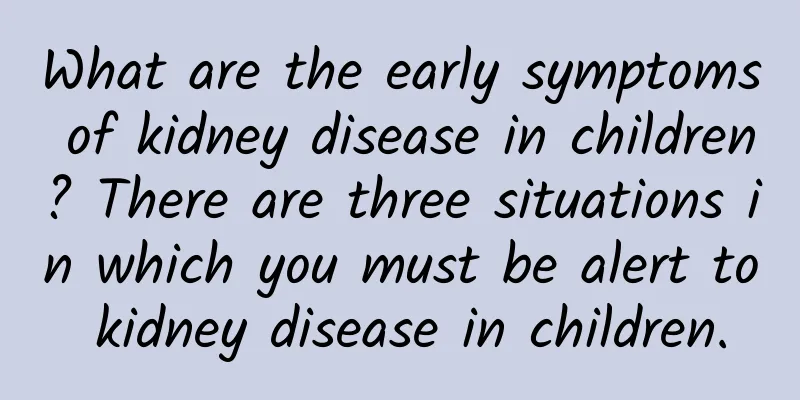The main symptoms of neonatal jaundice

|
The main symptom of neonatal jaundice is yellowing of the skin, sclera and whites of the eyes, which is caused by elevated bilirubin levels in the newborn. If jaundice is found within 24 hours after birth, or if the jaundice expands, deepens in color, or lasts for a long time, you need to seek medical attention immediately. 1 Common causes Neonatal jaundice is mainly divided into two categories: physiological jaundice and pathological jaundice. Physiological jaundice: Because the newborn's liver has a weak ability to metabolize bilirubin, bilirubin accumulates in the blood. It usually appears 2-3 days after birth and disappears in about 7-10 days. Pathological jaundice: It may be caused by hemolytic diseases such as maternal-fetal blood type incompatibility, infectious diseases such as neonatal sepsis, bile duct obstruction, etc. It usually appears within 24 hours after birth and requires medical intervention. 2 Main symptoms Mild jaundice: Slight yellowing of the skin and sclera, usually starting on the head and then possibly extending to the chest and extremities. Severe jaundice: Jaundice extends to the extremities, and the skin color turns dark yellow or even orange-yellow, which may be accompanied by drowsiness, difficulty feeding, or abnormal crying. Bilirubin encephalopathy kernicterus: In rare cases, excessive bilirubin can penetrate into the central nervous system and cause damage to the nervous system, such as abnormal muscle tone, slow reaction, convulsions, etc. This is a serious complication and requires immediate medical attention. 3. Coping and Treatment Physiological jaundice: Increase breastfeeding to promote the excretion of bilirubin through feces. It is ideal to maintain 8-12 feedings a day. Watch for changes in jaundice; if it subsides significantly, usually no treatment is needed. Phototherapy: Pathological jaundice or severe physiological jaundice can be treated with special wavelengths of blue light, which helps break down bilirubin so that it can be excreted through urine or feces. Drug treatment: In some cases, phenobarbital can be used to help the liver metabolize it. The specific medication should be determined by the doctor based on the condition. Blood transfusion or exchange transfusion therapy: If jaundice is severe or complicated by hemolysis, exchange transfusion therapy can be used to lower bilirubin levels. Neonatal jaundice is a common problem, but its severity varies depending on the cause and duration of the jaundice. Parents need to closely observe changes in the skin color and feeding of the newborn, and seek medical attention as soon as possible if any abnormalities are found. Doctors can assess bilirubin levels through blood tests and take necessary interventions. Early treatment can usually significantly improve the prognosis. |
<<: Can Yinzhihuang Granules be taken by newborns with jaundice?
>>: Is mumps in children contagious to adults?
Recommend
What should I do if my child has recurrent eczema? What are the treatments for recurrent eczema in children?
When there is a significant change in the weather...
How to care for children after hernia surgery What are the precautions after hernia surgery in children
Many boys will find that their genitals are swoll...
Does hernia in children have any impact on adulthood?
Hernias are more common in children. If they are ...
List of contraindications for breast milk jaundice. Can breast milk jaundice be prevented by vaccination?
After the baby is born, it is necessary to give v...
ADHD Self-Test 40 Questions
ADHD, also known as attention deficit hyperactivi...
What foods should children with pneumonia avoid eating? What tests should be done for children with pneumonia?
Pneumonia is a common disease, and children are t...
Is pneumonia so easy to get in children?
Pneumonia is a common pneumonia disease that can ...
What is the reason why children keep coughing repeatedly? What should I do if my child keeps coughing repeatedly?
In daily life, children often have symptoms of re...
What causes Kawasaki disease in children?
Kawasaki disease in children is mainly caused by ...
Is polio harmful to the body?
We all know that children's resistance is not...
Should we be careful about influenza in children in autumn and winter? Five pathogenic factors of influenza in children
Childhood influenza mainly refers to infant influ...
What are the secrets to preventing and treating breast milk diarrhea?
What are the secrets to prevent and treat breast ...
How to diagnose acute laryngitis in children best
What is the best way to diagnose acute laryngitis...
How to treat hand, foot and mouth disease in a four-year-old child
The treatment of hand, foot and mouth disease in ...
Mild polio is similar to normal people
The daily life of patients with mild polio may be...









